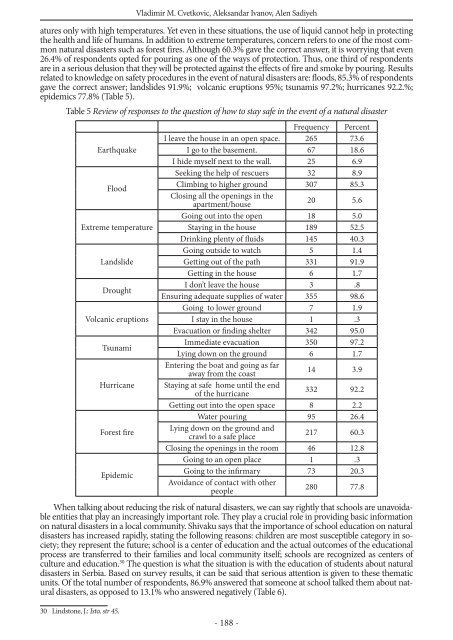- Page 1:
MEĐUNARODNI NAUČNI SKUP „DANI A
- Page 4 and 5:
Publisher ACADEMY OF CRIMINALISTIC
- Page 6 and 7:
INTERNATIONAL SCIENTIFIC CONFERENCE
- Page 9:
P R E F A C E Dear readers, In fron
- Page 12 and 13:
TABLE OF CONTENTS Dragan Djukanovic
- Page 15:
Topic III CONTEMPORARY SECURITY STU
- Page 18 and 19:
Mladen Bajagic, Sasa Mijalkovic car
- Page 20 and 21:
Mladen Bajagic, Sasa Mijalkovic −
- Page 22 and 23:
Mladen Bajagic, Sasa Mijalkovic 1)
- Page 24 and 25:
Mladen Bajagic, Sasa Mijalkovic 23.
- Page 26 and 27:
Radoslav Gacinovic At the beginning
- Page 28 and 29:
Radoslav Gacinovic Kosovo and Metoh
- Page 30 and 31:
Radoslav Gacinovic and mutual relat
- Page 33 and 34:
UDC: 364-787.3 PSYCHOSOCIAL SUPPORT
- Page 35 and 36:
PSYCHOSOCIAL SUPPORT IN EMERGENCY S
- Page 37 and 38:
PSYCHOSOCIAL SUPPORT IN EMERGENCY S
- Page 39:
PSYCHOSOCIAL SUPPORT IN EMERGENCY S
- Page 42 and 43:
Vesna Nikolic-Ristanovic, Sanja Cop
- Page 44 and 45:
Vesna Nikolic-Ristanovic, Sanja Cop
- Page 46 and 47:
Vesna Nikolic-Ristanovic, Sanja Cop
- Page 48 and 49:
Vesna Nikolic-Ristanovic, Sanja Cop
- Page 50 and 51:
Vesna Nikolic-Ristanovic, Sanja Cop
- Page 52 and 53:
Neven Cveticanin, Aleksandar Djokic
- Page 54 and 55:
Neven Cveticanin, Aleksandar Djokic
- Page 56 and 57:
Neven Cveticanin, Aleksandar Djokic
- Page 58 and 59:
Neven Cveticanin, Aleksandar Djokic
- Page 60 and 61:
Neven Cveticanin, Aleksandar Djokic
- Page 63 and 64:
THE CONCEPT OF SECURITY AND SECURIT
- Page 65 and 66:
THE CONCEPT OF SECURITY AND SECURIT
- Page 67 and 68:
THE CONCEPT OF SECURITY AND SECURIT
- Page 69 and 70:
THE CONCEPT OF SECURITY AND SECURIT
- Page 71 and 72:
UDC: 349.6 502.14 504.5/.6 POSSIBIL
- Page 73 and 74:
POSSIBILITIES TO RAISE AWARENESS OF
- Page 75 and 76:
POSSIBILITIES TO RAISE AWARENESS OF
- Page 77 and 78:
POSSIBILITIES TO RAISE AWARENESS OF
- Page 79 and 80:
UDC: 343.85:343.341(497.7) 343.85:3
- Page 81 and 82:
DEVELOPMENTS IN THE COUNTER-TERRORI
- Page 83 and 84:
DEVELOPMENTS IN THE COUNTER-TERRORI
- Page 85 and 86:
DEVELOPMENTS IN THE COUNTER-TERRORI
- Page 87 and 88:
DEVELOPMENTS IN THE COUNTER-TERRORI
- Page 89 and 90:
DEVELOPMENTS IN THE COUNTER-TERRORI
- Page 91 and 92:
UDC: 327.56::351.86(497.7) 327.51(4
- Page 93 and 94:
GLOBAL THREATS TO NATIONAL SECURITY
- Page 95 and 96:
GLOBAL THREATS TO NATIONAL SECURITY
- Page 97 and 98:
GLOBAL THREATS TO NATIONAL SECURITY
- Page 99:
GLOBAL THREATS TO NATIONAL SECURITY
- Page 102 and 103:
Martin Meteňko, Ján Hejda forming
- Page 104 and 105:
Martin Meteňko, Ján Hejda Ing. Pe
- Page 106 and 107:
Martin Meteňko, Ján Hejda examine
- Page 108 and 109:
Martin Meteňko, Ján Hejda of Crim
- Page 110 and 111:
Martin Meteňko, Ján Hejda 21. MAR
- Page 113 and 114:
CONTEMPORARY VIEWS ON NEW FORMS OF
- Page 115 and 116:
CONTEMPORARY VIEWS ON NEW FORMS OF
- Page 117 and 118:
CONTEMPORARY VIEWS ON NEW FORMS OF
- Page 119:
CONTEMPORARY VIEWS ON NEW FORMS OF
- Page 122 and 123:
Dalibor Kekic, Milos Milenkovic red
- Page 124 and 125:
Dalibor Kekic, Milos Milenkovic Fra
- Page 126 and 127:
Dalibor Kekic, Milos Milenkovic tiv
- Page 128 and 129:
Dalibor Kekic, Milos Milenkovic wor
- Page 131 and 132:
MODERN APPROACHES IN THE CREATION O
- Page 133 and 134:
MODERN APPROACHES IN THE CREATION O
- Page 135 and 136:
MODERN APPROACHES IN THE CREATION O
- Page 137:
MODERN APPROACHES IN THE CREATION O
- Page 140 and 141:
Dragan Djukanovic Albanians and min
- Page 142 and 143:
Dragan Djukanovic Often these proce
- Page 144 and 145:
Dragan Djukanovic ing the EU the po
- Page 147 and 148:
UDC: 327.56::351.88(497) 005.575/.5
- Page 149 and 150:
PROMOTION OF THE REGIONAL SECURITY
- Page 151 and 152: PROMOTION OF THE REGIONAL SECURITY
- Page 153: PROMOTION OF THE REGIONAL SECURITY
- Page 156 and 157: Marija Lucic-Catic, Dina Bajraktare
- Page 158 and 159: Marija Lucic-Catic, Dina Bajraktare
- Page 160 and 161: Marija Lucic-Catic, Dina Bajraktare
- Page 162 and 163: Marija Lucic-Catic, Dina Bajraktare
- Page 164 and 165: Marija Lucic-Catic, Dina Bajraktare
- Page 167 and 168: UDC: 341.222(73) 341.222(470) 341.2
- Page 169 and 170: COMPARATIVE OVERVIEW OF BORDER SECU
- Page 171 and 172: COMPARATIVE OVERVIEW OF BORDER SECU
- Page 173 and 174: COMPARATIVE OVERVIEW OF BORDER SECU
- Page 175 and 176: COMPARATIVE OVERVIEW OF BORDER SECU
- Page 177 and 178: UDC: 340.134:[334.728:351.759.4/.5(
- Page 179 and 180: STRATEGIC AND LEGAL BASIS FOR STREN
- Page 181 and 182: STRATEGIC AND LEGAL BASIS FOR STREN
- Page 183 and 184: STRATEGIC AND LEGAL BASIS FOR STREN
- Page 185: STRATEGIC AND LEGAL BASIS FOR STREN
- Page 188 and 189: Sinisa Djukic Federation of Bosnia
- Page 190 and 191: Sinisa Djukic DIRECTIONS FOR IMPROV
- Page 192 and 193: Sinisa Djukic The rule that the int
- Page 194 and 195: Sinisa Djukic 8. Zakon o krivičnom
- Page 196 and 197: Vladimir M. Cvetkovic, Aleksandar I
- Page 198 and 199: Vladimir M. Cvetkovic, Aleksandar I
- Page 200 and 201: Vladimir M. Cvetkovic, Aleksandar I
- Page 204 and 205: Vladimir M. Cvetkovic, Aleksandar I
- Page 206 and 207: Vladimir M. Cvetkovic, Aleksandar I
- Page 208 and 209: Vladimir M. Cvetkovic, Aleksandar I
- Page 210 and 211: Maja Ruzic receive Western financia
- Page 212 and 213: Maja Ruzic From the collapse of the
- Page 214 and 215: Maja Ruzic REFERENCES 1. Black, J.
- Page 216 and 217: Nenad Bingulac possible terrorist a
- Page 218 and 219: Nenad Bingulac such a large number
- Page 220 and 221: Nenad Bingulac sexual exploitation
- Page 222 and 223: Nenad Bingulac The aim of our resea
- Page 225 and 226: UDC: 343.848/.85 LEGAL PROBLEMS IN
- Page 227 and 228: LEGAL PROBLEMS IN USING PREVENTIVE
- Page 229 and 230: LEGAL PROBLEMS IN USING PREVENTIVE
- Page 231: LEGAL PROBLEMS IN USING PREVENTIVE
- Page 234 and 235: Vladimir V. Vekovic the imprisonmen
- Page 236 and 237: Vladimir V. Vekovic In order to ens
- Page 239 and 240: PROTOCOLS OF THE CONGRESS OF PARIS
- Page 241 and 242: PROTOCOLS OF THE CONGRESS OF PARIS
- Page 243 and 244: PROTOCOLS OF THE CONGRESS OF PARIS
- Page 245 and 246: PROTOCOLS OF THE CONGRESS OF PARIS
- Page 247 and 248: UDC: 340.134:35.072.6(497.11) TOWAR
- Page 249 and 250: TOWARDS NEW SOLUTIONS IN THE LAW ON
- Page 251 and 252: TOWARDS NEW SOLUTIONS IN THE LAW ON
- Page 253:
TOWARDS NEW SOLUTIONS IN THE LAW ON
- Page 256 and 257:
Branislav Ristivojevic policy. The
- Page 258 and 259:
Branislav Ristivojevic them to crea
- Page 260 and 261:
Branislav Ristivojevic DIFFERENT CO
- Page 262 and 263:
Branislav Ristivojevic 7. Dina Fran
- Page 264 and 265:
Vladan Petrov, Darko Simovic, Srete
- Page 266 and 267:
Vladan Petrov, Darko Simovic, Srete
- Page 268 and 269:
Vladan Petrov, Darko Simovic, Srete
- Page 271 and 272:
CASE-LAW OF THE EUROPEAN COURT OF H
- Page 273 and 274:
CASE-LAW OF THE EUROPEAN COURT OF H
- Page 275 and 276:
CASE-LAW OF THE EUROPEAN COURT OF H
- Page 277 and 278:
CASE-LAW OF THE EUROPEAN COURT OF H
- Page 279 and 280:
CASE-LAW OF THE EUROPEAN COURT OF H
- Page 281 and 282:
UDC: 343.988(497.11) 342.7:343.232-
- Page 283 and 284:
THE LEGAL STATUS OF THE INJURED PAR
- Page 285 and 286:
THE LEGAL STATUS OF THE INJURED PAR
- Page 287:
THE LEGAL STATUS OF THE INJURED PAR
- Page 290 and 291:
Vesna Knezevic-Predic, Dejan Pavlov
- Page 292 and 293:
Vesna Knezevic-Predic, Dejan Pavlov
- Page 294 and 295:
Vesna Knezevic-Predic, Dejan Pavlov
- Page 296 and 297:
Vesna Knezevic-Predic, Dejan Pavlov
- Page 299 and 300:
UDC: 341.645.5 341.49:341.322.5(497
- Page 301 and 302:
THE INTERNATIONAL CRIMINAL TRIBUNAL
- Page 303 and 304:
THE INTERNATIONAL CRIMINAL TRIBUNAL
- Page 305 and 306:
THE INTERNATIONAL CRIMINAL TRIBUNAL
- Page 307 and 308:
THE INTERNATIONAL CRIMINAL TRIBUNAL
- Page 309 and 310:
VIOLENCE AGAINST LGBT 1 PERSONS 2 Z
- Page 311 and 312:
VIOLENCE AGAINST LGBT PERSONS invol
- Page 313 and 314:
VIOLENCE AGAINST LGBT PERSONS In ed
- Page 315 and 316:
VIOLENCE AGAINST LGBT PERSONS indep
- Page 317:
VIOLENCE AGAINST LGBT PERSONS 28. P
- Page 320 and 321:
Radomir Zekavica who have the right
- Page 322 and 323:
Radomir Zekavica in a democratic so
- Page 324 and 325:
Radomir Zekavica term is primarily
- Page 326 and 327:
Radomir Zekavica 3. Europan Code of
- Page 328 and 329:
Slavisa Vukovic the area. The dark
- Page 330 and 331:
Slavisa Vukovic rural) about the cr
- Page 332 and 333:
Slavisa Vukovic policies should be
- Page 334 and 335:
Slavisa Vukovic 8. Konstantinović-
- Page 336 and 337:
Radosav Risimovic, Dragana Kolaric
- Page 338 and 339:
Radosav Risimovic, Dragana Kolaric
- Page 340 and 341:
Radosav Risimovic, Dragana Kolaric
- Page 342 and 343:
Radosav Risimovic, Dragana Kolaric
- Page 345 and 346:
UDC: 341.645(4-672EU) 34(4-672EU) R
- Page 347 and 348:
RELEVANCE OF CONCEPTUALIZING THE RE
- Page 349 and 350:
RELEVANCE OF CONCEPTUALIZING THE RE
- Page 351 and 352:
RELEVANCE OF CONCEPTUALIZING THE RE
- Page 353:
RELEVANCE OF CONCEPTUALIZING THE RE
- Page 356 and 357:
Ivana Krstic-Mistridzelovic, Mirosl
- Page 358 and 359:
Ivana Krstic-Mistridzelovic, Mirosl
- Page 360 and 361:
Ivana Krstic-Mistridzelovic, Mirosl
- Page 362 and 363:
Ivana Krstic-Mistridzelovic, Mirosl
- Page 364 and 365:
Marija Milenkovska with human right
- Page 366 and 367:
Marija Milenkovska VIOLATIONS OF TH
- Page 368 and 369:
Marija Milenkovska Court decisions
- Page 370 and 371:
Marija Milenkovska role of the Cour
- Page 373 and 374:
CONDITIONALLY DEFERRED PROSECUTION
- Page 375 and 376:
CONDITIONALLY DEFERRED PROSECUTION
- Page 377 and 378:
CONDITIONALLY DEFERRED PROSECUTION
- Page 379 and 380:
CONDITIONALLY DEFERRED PROSECUTION
- Page 381 and 382:
CONDITIONALLY DEFERRED PROSECUTION
- Page 383 and 384:
UDC: 343.341(510) 323.28(510) CHINA
- Page 385 and 386:
CHINA’S WAR ON TERROR AND PUBLIC
- Page 387 and 388:
CHINA’S WAR ON TERROR AND PUBLIC
- Page 389 and 390:
CHINA’S WAR ON TERROR AND PUBLIC
- Page 391 and 392:
CHINA’S WAR ON TERROR AND PUBLIC
- Page 393 and 394:
UDC: 351.74/.75 342.72/.73 CONTROLL
- Page 395 and 396:
CONTROLLING THE POLICE THROUGH THE
- Page 397 and 398:
CONTROLLING THE POLICE THROUGH THE
- Page 399 and 400:
CONTROLLING THE POLICE THROUGH THE
- Page 401 and 402:
UDC: 341.4:[57+61 INTERNATIONAL LAW
- Page 403 and 404:
INTERNATIONAL LAW REQUIREMENTS IN R
- Page 405 and 406:
INTERNATIONAL LAW REQUIREMENTS IN R
- Page 407 and 408:
UDC: 343.9.02(497.4) 343.123.12(497
- Page 409 and 410:
EFFECTIVE PROSECUTION OF CRIME AS A
- Page 411 and 412:
EFFECTIVE PROSECUTION OF CRIME AS A
- Page 413 and 414:
EFFECTIVE PROSECUTION OF CRIME AS A
- Page 415 and 416:
EFFECTIVE PROSECUTION OF CRIME AS A
















